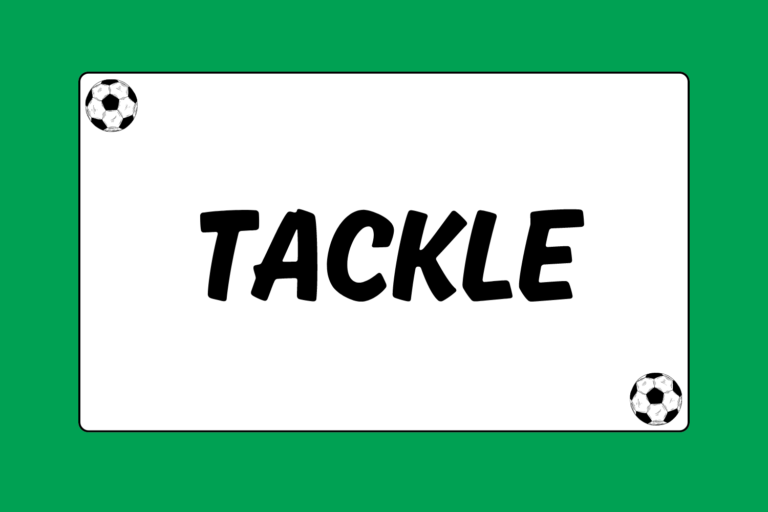Goalkeeping is, without a shadow of a doubt, the most thankless job in all of soccer. If you find yourself minding the net for your team, keep in mind that the praise for a win will usually be attributed to your goal-scoring teammates, but a loss will almost always be laid on your overburdened shoulders. This is the responsibility that you undertake when you play goalkeeper. You are the last line of defense and you have to be the general on the field.
It takes both mental toughness and proper technique to defend the net effectively. Here’s an overview of the skills and mechanics you need to learn in order to be a successful goalkeeper.
The Ready Position
The first thing goalkeepers need to learn is the “ready position.” This is the position you want to be in when anticipating a shot. Below is a checklist of things you want to ensure you are doing when a shot on goal seems imminent:
Step 1: Be Square to the Ball
You want your chest to be perpendicular to the path of the ball. It is called getting square because you form a 90 degree angle with your torso and the potential trajectory line of the ball. Naturally this is not a precise science because there are many factors that can alter the path of the shot, but it should give you the highest probability of putting yourself in a position to make a save.
Step 2: Keep your Knees Bent
Keeping your knees bent will allow you to leap faster than if your knees are locked. No matter what situation you are in, you need to bend your knees in order to generate the force that will elevate you. By keeping them bent in the “ready position,” you will achieve this faster.
Step 3: Keep your Weight on the Balls of your Feet
By keeping your weight on the balls of your feet you will be able to move faster when you need to defend a shot. It’s all about reaction speed when you are a goalkeeper, and leaning forward and focalizing your center of gravity will increase the speed with which you react.
Step 4: Keep your Hands at your Side
By keeping your hands at your side, you put yourself in the optimal position to make a save. You can easily extend your left or right arm out to either side when diving, or you can bring both hands up and in front of you to secure or parry an incoming shot.
Footwork
Shuffle Step
When you position yourself in goal, always shuffle from side to side so that you can keep your torso perpendicular to the ball. Try to avoid crossing your legs if possible because they may become entangled and trip you up.
Cross Step
If you absolutely must sprint somewhere and are forced to abandon the shuffle step, twist your torso so that no matter what direction you are running, your torso is always perpendicular to the ball.
Attack the Ball
When a ball is rolling towards you, don’t just wait for it to arrive in your outstretched arms. Instead, attack the ball and secure it as soon as possible. This will let opposing players know that you are serious about defending your goal, and it will discourage them from looking for second chance shots.
Recovery
If you dive to make a save and don’t secure the ball, make sure that you pop back up on your feet as soon as possible and get yourself in position. Just because you made a save doesn’t mean the game is going to stop to marvel at your brilliance. You need to get back in the “ready position” as soon as humanly possible.
“The goalkeeper is the jewel in the crown and getting at him should be almost impossible. It’s the biggest sin in football to make him do any work.”
George Graham
Scottish Player and Manager
Catching the Ball
Soft Hands
When you catch the ball, always use your hands and not your chest. Make sure that your hands are behind the ball, not on the sides of it. That way, if you can’t catch it, at least you will prevent it from going into the net. Your arms should be outstretched and you should use them to absorb the force of the ball. Also ensure that you do not lock your elbows so that your arms can give a little when absorbing the ball’s force.
Hold Your Ground
When you catch the ball make sure you don’t step backwards. This will show attackers that you are timid and unwilling to stake your claim on the pitch. You also never know how close you are to your goal line, and it would be a pity to make the save, only to walk the ball right into your own net. Keep your momentum moving forward and be aggressive to the ball.
The Contour Catch
When you catch the ball above your waist, make sure you position your hands so they form around the contour of the ball. This is done by creating a W shape with both hands, connect by the thumbs.
The Inverted Contour Catch
Similar to how the Contour Catch is used above the waist, you want to use the inverse or upside-down W shape for shots below the waist.
Ground or Rolling Balls
When facing hard shots on the ground, you should utilize the smother technique. The smother basically entails falling forward onto the ball while scooping it up in one fluid movement.
When facing slower, softer shots, you can generally use the straight leg pick-up. Simply bend over to pick the ball and use your legs as a defensive fallback in case you bobble the ball.
Elevation
When catching a ball above the waist, try to catch it at the highest possible point. Your ability to use your hands is an edge over the opposing attackers that you should take full advantage of.
Protecting the Ball
It is paramount that you protect the ball at all cost, but don’t forget to catch it before you do. Too often a goalkeeper will bring a ball into their body before it is properly secured, only to bobble it away. Always remember to catch, then protect.
Keep your Head in the Game!
The goalkeepers own mind can be just as dangerous as the opposing team during a match. One mistake can start a downward spiral of lost confidence that eventually leads to ruin. If you make a mistake, pick yourself right back up and stay focused. It doesn’t matter if the goal was your fault or not, move forward and play to the best of your abilities.
Goal Kicks
When taking a goal kick, the ball must be placed anywhere within the 6-yard goal box, and must be stationary before you kick it back into play. While the goalkeeper is generally the one who takes the goal kick, any teammate on the field is eligible to take it. As the goalkeeper, if you are not comfortable taking the kick it is quite common to have one of your defenders take it for you.
Punting vs. Throwing
When you secure the ball with your hands, you have the option of either punting or throwing the ball to your teammates. Throwing the ball is usually used to get the ball back into play quickly, or to accurately pass it to a nearby teammate. Conversely, punting allows you to achieve greater distance but with far less accuracy.
Once you have secured the ball with your hands, you have six seconds to put it into play. If you do not make a play in the allotted amount of time, the referee will award an indirect free kick to the opposing team.
Receiving a Back-Pass
When a defender passes the ball back to you, you may only play the ball with your feet. If you pick up a ball that is deliberately passed back to you, the referee will award an indirect free kick to the opposing team. The only exception to this rule is if your teammate heads the ball back to you, in which case you are allowed to play the ball with your hands.
Mind the Net
Hopefully this guide has provided you with the necessary tools to excel on the field as a beginning goalkeeper. Once you have mastered these techniques, feel free to continue to the Intermediate Goalkeeping Guide, where more advanced techniques and tactics are explored.






